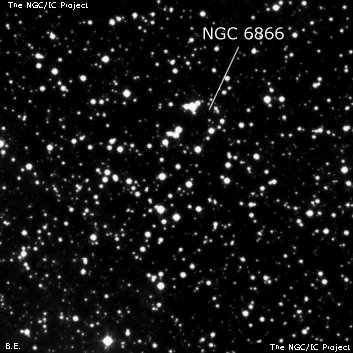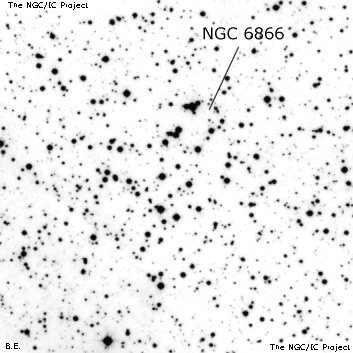NGC/IC Project Restoration Effort
(This is a very very beta version)
NGC6866


Basic Information
Location and Magnitude
Right Ascension: 20:3:55.1
Declination: +44:9:33
Constellation: CYG
Visual Magnitude: 7.6
Historic Information
Discoverer: Herschel C.
Year of discovery: 1783
Discovery aperture: 4.2
Observational
Summary description: Cl, L, vRi, cC
Sub-type: II2m
Corwin's Notes
=====
NGC 6866. WH found this cluster on 11 Sept 1790 and described it as "A very
rich cl of L stars considerably compressed; above 15' diam. By the size of
the stars, it is situated among the milky way towards us." This matches the
cluster that we find at his position. I'm not quite sure how to take his
second sentence, however. My guess is that he means to suggest that the
cluster is superposed on the Milky Way.
So far, so good. JH looked for his father's object in just one sweep and
found "A coarse rough cluster. Taken for VII. 59, but the place does not
agree." In the sweep, he says the same thing, but notes that the position is
that of a double star. His RA is close to that of his father, but he places
the double -- and the cluster -- ten arcminutes further south. There is no
mistake in his reduction, and the cluster is close to neither the northern or
southern limits of the sweep, so he somehow simply missed the cluster.
Another curiosity is that when it came time to assemble the GC, he adopted his
own position, but his father's description for the cluster. Dreyer copied
this faithfully into the NGC, so we have had the wrong declination attached to
the cluster for a well over a century. As far as I know, Brian Skiff was the
first to notice this, but I have not checked all of the cluster catalogues.
Steve's Notes
=====
NGC 6866
17.5" (9/7/91): about 100 stars in a 20'x10' region are visible at 100x. Appears rich and very appealing. The main string is very elongated roughly E-W and contains a brighter intersecting subgroup 8'x2' NW-SE of about 45 stars with a close triple star on the NW end consisting of a mag 10 star and two very faint companions. Two mag 10-10.5 stars are at the SE end of this string. The western end of the main string curves north into a nice semi-circle.



